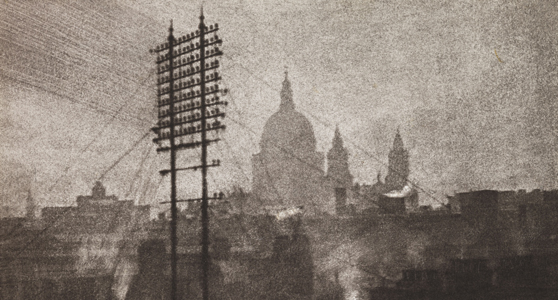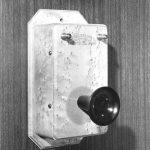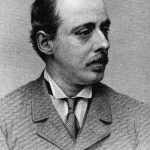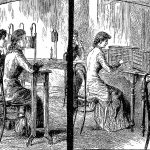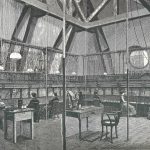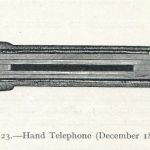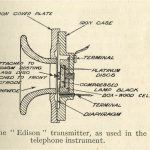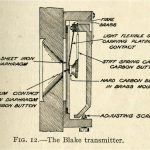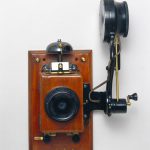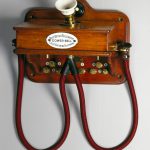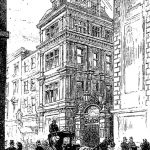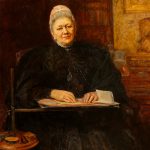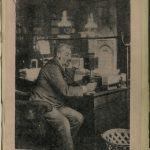Troublesome telephony: how users and non-users shaped the development of early British exchange telephony
Article DOI: https://dx.doi.org/10.15180/150308
Abstract
When exchange telephony was first marketed to the British public by the early telephone companies in the late nineteenth century it was as an intuitive technology requiring no specialist knowledge or training. This has gone unquestioned in subsequent telephone historiography but, as this article demonstrates, telephone instruments and systems were not always unproblematic or easy to use. Whilst other scholars have discussed important factors in the development and uptake of telephony, such as business economics and intellectual property, this article focuses on usage, and argues that difficulties in using telephone instruments and systems also influenced key changes in the operations of early British exchange systems. To understand these responses and developments it is necessary to look at the opinions and complaints of both users and non-users of telephone exchange systems. In investigating non-users as well as users, this article is influenced by the work of Sally Wyatt in Oudshoorn and Pinch’s (2003) edited volume regarding users and non-users of technologies. Recovering the reactions of such people is possible through extensive use of letters received by the telephone companies or published in the periodical press, and opinions voiced at select committee meetings investigating the state of the country’s telephone system. In recovering the difficulties early users and non-users faced when confronted with exchange telephone systems this article emphasises the importance of problematising the historical uptake of new technologies, and highlights how, in the case of early British telephony in particular, these problems can reveal specific facts both about historical telephone use-experience and about how exchange telephony spread around the country.
Keywords
Britain, history of technology, history of telecommunications, nineteenth century, social history, telephony
Introduction
https://dx.doi.org/10.15180/150308/002I am very glad to see from the letters which have appeared in your paper that there is a dissatisfaction with the present system of working these telephones. As far as I am concerned I find my telephone almost useless, as I occupy more time in communicating through it than I should do if I went to the offices or places of business of nine out of ten of the persons with whom I wish to communicate. I have consequently given notice of my intention to discontinue the use of it when the term for which my subscription is paid ceases.
Clifford Dunn, Leeds telephone exchange subscriber, December 1881[1]
The simplicity of the instruments and systems of late-nineteenth century British exchange telephony, and the ease with which anyone could use them, was emphasised in most early telephone marketing (Baldwin, 1925; Feuerstein, 1990) and has been a feature, often tacitly assumed, of subsequent histories ever since.[2] Indeed, when the administrative historian Charles R Perry, writing in 1977 (Perry, 1977), asserted that the growth of British exchange telephony had been delayed in this period, he reached this conclusion largely because he assumed that the telephones of the time were unproblematic instruments, the benefits of which should have been immediately obvious to all.[3] However, users of late nineteenth-century telephone systems, such as Clifford Dunn, a Leeds solicitor quoted above from his 1888 letter to the Yorkshire Post, often found they were not as intuitive or as useful as expected.
Perry’s work, and his assertion of delay, has come to constitute the received view of British telephone history; many scholars have uncritically used Perry’s narrative slant to sum up early British telephony as underdeveloped.[4] Perry’s approach has therefore depressed interest in this rich but under-researched field. In an attempt to shed new light on discussions of early British telephony, this article examines problems which people in Britain encountered when they first interacted with exchange telephony from 1879, when the first exchanges were established, until the early 1890s, when the main intercity telephone wires, called trunk lines, were nationalised. Considering these problems, and their solutions, allows for a better understanding of the development of exchange systems in Britain in this period. Such problems also reveal why people might have chosen not to use exchange telephony, or been unable to use it. As the Science Museum marks the opening of the new Information Age gallery, at a time when telecommunication technologies in general, and social media in particular, are playing more and more central roles in our everyday lives, it is interesting to reflect on the ways in which people in the late nineteenth century responded to the possibilities opened up by what was arguably the first network-based telecommunications technology.[5] (Kingsbury, 1915)
While other historical treatments of telephony have focused on areas such as business and institutional history and patents (Feuerstein, 1990), this paper considers usage as another factor in the development and proliferation of telephony. In exploring the social history of technology, this article has been influenced by Graeme Gooday’s work on electricity with regard to Thomas Hughes; in his authoritative book on the spread and development of electric power, Hughes analysed this technology as a system which relied on a network of many different components, all of which had to be working in order for the whole to function efficiently (Hughes, 1983). However, Hughes failed to include the human users as equally important components of the system. As Gooday has pointed out, it is not correct simply to assume that home-owners wanted electricity, as many did not, and thus a tension needed to be resolved whereby either the technology or the attitude of the public needed to be altered in order for electric power to spread (Gooday, 2008).
Like electric power, exchange telephony was a system, a network technology. However, the role of human users as components in telephone exchange networks was even more important in comparison to electric power, as the utility of the network to the individual was directly determined by the other people using it (Milne, 2007).[6] This meant that the attitudes of users comprised a key aspect for the providers of the technology to consider when they were seeking to optimise the functioning of the system. Likewise, problems affecting one person affected many, and problems that caused people not to use the technology were problems for the system as a whole. An analysis of these problems, and their solutions, will demonstrate the ways in which British exchange telephony developed in response to the requirements of the social components of the system.
The focus on the ability of non-users of technology to shape technological development is influenced by Sally Wyatt. She has argued that non-users of technologies, those who, willingly or not, either stop using a certain technology or never use it in the first place, are important to consider when looking at the development of that technology (Wyatt, 2003). These non-users of technologies can exert just as much influence over the development of the technologies in question as the users. Because the producers and suppliers of technologies want at least some of the non-users to become users, they are willing to alter technologies according to the opinions and attitudes of this potential market. As an examination of the problems with telephony will show, those who did not use telephone exchange systems played a larger role in their development than non-users of other technologies did in the development of those technologies. This was partly for the reasons Wyatt described, and partly for other reasons unique to telephony.
Thus, the problems examined here will be used to do three things: firstly, to counter Perry’s narrative of delay by demonstrating that exchange telephony was not in this period an obviously useful technology which everyone, by default, would have wanted to use.
Secondly, building on Hughes and Gooday, this article will determine the extent to which exchange telephony developed in response to these problems, and, finally, it will consider the impact that non-users had in shaping early telephone exchange development, thus supporting Wyatt’s thesis.
A brief overview of exchange telephony in Britain
https://dx.doi.org/10.15180/150308/003After Alexander Graham Bell’s telephone instrument was first successfully demonstrated in Britain in August 1877,[7] the first telephone company in Britain, called simply the Telephone Company Ltd., was established in June 1878. A year later, in August 1879, another company, the Edison Telephone Company of London, was founded to work the competing patents of Thomas Edison (Baldwin, 1925). These companies both began to provide exchange service in London in August and September of 1879 (Kingsbury, 1915). Towards the end of the year, however, the Post Office began to take legal action against both companies for infringement of its monopoly over telegraphic communications. This monopoly had been conferred upon the department by the 1869 Telegraph Act, by which the State purchased the telegraphic systems of the country. Now the Post Office, concerned to protect the public investment in the national telegraph system, pointed out that the telephone was, effectively, a form of telegraph, and thus was included in its monopoly. In response to this pressure, and due also in part to the fact that neither company alone had a commercially impressive telephone transmitter and receiver combination, the two companies amalgamated to form the United Telephone Company (UTC) in May 1880 (Baldwin, 1925, Kingsbury, 1915).[8]

In December 1880 the ruling was returned that the telephone was legally a telegraph, and so came under the monopoly of the Postmaster General; the Post Office then offered to issue licences to any companies which desired to establish exchanges. The licences would be strictly local, with telephone service limited to a radius of a few miles from the centre of the town. The Post Office would construct and maintain trunk lines between towns, and rent these to the companies. In addition, companies were to pay a ten per cent royalty on their gross receipts to the Post Office, and were not allowed to open call offices – rooms run by the companies where people could go to use telephones – for the use of anyone who was not a subscriber (Baldwin, 1925). The Post Office also reserved the right to establish its own exchanges, which it did in towns such as Newcastle, Leicester, Hull and Plymouth.
The UTC established subsidiary companies to run exchanges around the country, and by January 1885 there were seven companies covering the UK (Baldwin, 1925). The most important of these were the Lancashire and Cheshire Telephonic Exchange Company (L&C) and the National Telephone Company (NTC), which covered Scotland, Yorkshire and the Midlands. As well as the royalty to the Post Office, these companies also paid the UTC for the use of its instruments.[9] There were also some smaller independent companies established and maintained around the country, but these were gradually bought out by the larger companies over the course of the 1880s and early 1890s.[10] The UTC took legal action against anyone using any other form of telephone, gaining a master patent over British telephony (Baldwin, 1925).
By 1884, however, pressure from Parliament, the press and the companies began to mount on the Postmaster General Henry Fawcett to alter the conditions of the licences (Baldwin, 1925). To this end he held a consultation with all the exchange telephone companies in July and announced new licensing terms which abolished the local restrictions and allowed trunk line expansion and public call offices, although still upholding the ten per cent royalty payment. The new licences were issued in November, and subsequently the trunk line network expanded rapidly (Baldwin, 1925; Kingsbury, 1915). Liverpool and Manchester were connected together, and also to the Yorkshire district of the NTC and to the Northern District Telephone Company, which covered the Newcastle area. This resulted in a relatively dense network. However, London remained telephonically isolated from the provinces until July 1890, when it was connected to Birmingham, and thus to the rest of the north of England (Electrician, 1886; Baldwin, 1925).[11]
Under the terms of the licences, the Government had reserved the right to purchase the telephone companies at certain intervals, and the first was at the end of 1890.[12] With this deadline approaching, the companies decided to provide a united front through amalgamation. As their licences did not permit them to directly merge, and as the Postmaster General was against their decision, the UTC, L&C and NTC achieved their aim by having the NTC, the biggest of the three, buy up the other two in May 1889. This process of amalgamation continued until, by 1894, the NTC was the only telephone company in the UK (Baldwin, 1925, Economist, 1889).
Another reason behind the amalgamation was the imminent expiry of the key telephone patents – Bell’s in December 1890 and Edison’s in July 1891 (Baldwin, 1925 p 193). This prompted threats of competition, such as from a new co-operative company called the Mutual Telephone Company in Manchester, and from the New Telephone Company, run by the 8th Duke of Marlborough, George Spencer-Churchill, which he claimed would provide cheaper more efficient telephony in London (Baldwin, 1925 pp 194–7 and pp 232–6). In response to this the National Telephone Company reduced its prices in the provinces twice between May 1890 and January 1891, but maintained the same charge (£20) in London (Baldwin, 1925 p 605). The Mutual Company ran a successful exchange for about two years, then sold its business to the Duke of Marlborough as part of his broader scheme to develop a rival company which would compete with the National Telephone Company across the country.[13]
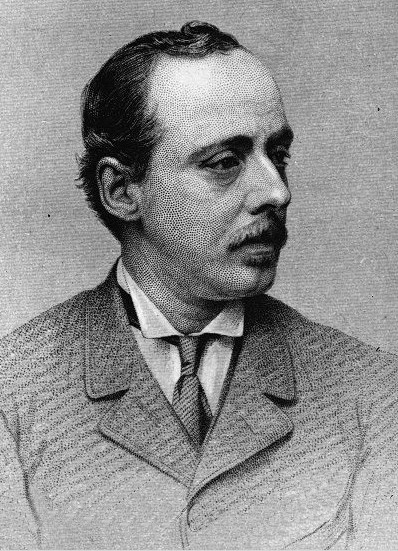
Meanwhile the Post Office had continued to run its own exchanges in certain towns, but only its Newcastle exchange was really successful (Electrician, 1892). By March 1892 there were only 35 exchanges, with only 4,691 subscribers’ lines between them (Baldwin, 1925 p 133). By contrast, at the time of amalgamation in 1889 the newly expanded NTC had a total of 23,585 subscribers’ lines; the Northern District Telephone Company and the South of England Telephone Company had 1,551 and 3,235 lines respectively when they merged with the NTC in 1890. The Western Counties and South Wales Company and the Sheffield Telephone Company had 4,027 and 1,415 lines respectively when they were absorbed into the NTC in 1892 (Baldwin, 1925 p 191-2).
In 1892 both the National Telephone Company and Marlborough’s New Telephone Company proposed Parliamentary Bills asking for greater powers when it came to erecting their wires, such that they would have more compulsory rights to overrule those who objected; they would also gain the power of breaking up streets in order to lay their wires underground (Baldwin, 1925 p 575). However, the Post Office opposed both Bills, instead proposing its own plan: it would purchase and run the trunk wires, allowing companies to run their own exchanges in individual towns and linking them with the exchanges of other companies in other towns to provide the best service for the public. These proposals passed in June as the Telegraph Act of 1892, and the preparations for buying up the trunklines began in August, reaching a conclusion with the eventual purchase in April 1896 (Baldwin, 1925 p 578 and pp 484-5).
However, although this was intended to encourage competition between private companies, after the Duke of Marlborough died in November 1892 the activities of the New Telephone Company languished and they merged with the National Telephone Company in 1893. With the end of the New Telephone Company, competition against the National Telephone Company from other private companies effectively ceased. Later on, around the turn of the century, there would be a push from some local authorities to establish systems of municipal telephony, for example in London, Glasgow and Hull. Apart from Hull, though, these failed within a few years. Then, in 1912, the entire telephone system was nationalised, and a new era of British telephony began (Robertson, 1947).
Before considering the complaints of telephone users and non-users below, it is useful to give some context regarding the cost of the flat-rate subscriptions required to use exchange telephony.[14] Until the rates were reduced in 1891, the price of exchange subscription in most towns and cities with exchanges run by UTC group companies was between £15 and £20.[15] By way of comparison, in London from 1877 the youngest Post Office telegraph boys were paid 7s. a week to deliver telegrams around the city (Hindmarch-Watson, 2012). Thus, employing a boy who could carry messages, and also packages, for a year would have been cheaper than getting an exchange telephone. The cost of subscription was a source of complaint across the country, and discouraged many from using the telephone (Electrician, 1886).[16] In Manchester, the Manchester Guardian called the £20 rate ‘absolutely prohibitive’[17] to most people who would want to use the telephone, and one London subscriber noted that when he tried to encourage his business associates to become subscribers they declined on the grounds of cost and poor service (Electrician, 1886). Sometimes those who started to use it had to stop because the cost was prohibitive, as one Glasgow subscriber wrote in 1883 (TJER, 1883). His firm had given up the telephone two years earlier, and many of his business friends had gradually done the same.
Thus, because of the relatively high cost of subscription, the main early use of exchange telephony was commercial, as Graeme Milne has noted (2007) – although wealthy aristocrats also often had an exchange connection – and key telephone users were predominantly male. Prominent groups of users, which often featured in early telephone directories (now held in the BT Archives) included hotels, railway companies and shipping firms, doctors, lawyers and stockbrokers. In a given town the dominant trade or industry would often also dominate the list of telephone subscribers, for example the steel industry in Sheffield, or the jute trade in Dundee; in Manchester it was the cotton trade, and in Bradford and Leeds, the wool industry. In the case of professional men such as doctors and lawyers, it is likely that they themselves would have been the main users of their telephones; however, in the offices of large commercial firms this would often have been delegated to younger clerks or office boys, who, as is discussed in more detail below, sometimes acted to screen their superiors’ incoming calls.
Addressing the problems
https://dx.doi.org/10.15180/150308/004In March 1878, Bell wrote a letter to a group of British investors who were in the process of establishing what would later become known as the Telephone Company. He prefaced his suggestions regarding the uses to which telephony might be put by emphasising that operating the instrument required no skill. The ease with which conversation could be conducted over the telephone, and the lack of previous knowledge required to operate the instruments, was an assertion repeated in telephone marketing produced by the Telephone Company and later by the UTC. It was emphasised for example in the companies’ published lists of subscribers, which in this period acted both as telephone directories and instruction manuals for users, and also as advertisements intended to promote the network to non-users (UTC, 1881). However, the complaints expressed in the early years of exchange telephony reveal details of what it was actually like to use the first exchanges, and the attitudes of users and non-users towards them. This provides a more nuanced picture of the use-experiences of individuals and communities as they interacted with this new technology for the first time. These complaints can then be compared across different times and places, and correlated with differences in various technical details peculiar to certain systems in order to build a picture of the advantages and disadvantages of different exchange systems. Thus, by understanding these problems, the wide variety of responses to the technology at the time can be better appreciated.
The specific problems users and non-users encountered with early exchange telephony can be best analysed by grouping them into four categories, starting with the difficulties users had when attempting to get connected to the exchange, and subsequently to the other telephone subscriber with whom they wished to speak. The second category comprises those problems users had in actually holding conversations, such as other noises, and sometimes other conversations, being audible on the telephone wire. Thirdly, negative attitudes of non-users towards overhead telephone wires will be considered, including how this impacted on the growth of the exchange system. The problems of the final category are those concerns which were expressed by users and non-users that having a telephone was stressful, and made them accessible to other people with whom they did not wish to speak. Throughout this analysis the ways in which these problems were treated by the companies, and how, if at all, they were resolved during this period, will be a key focus.
Getting through
The first problem confronting any would-be exchange user was calling up the exchange to ask the operator to connect them to another subscriber. During this period exchange equipment, including the apparatus used by subscribers, was not standardised around the country (Baldwin, 1925). This meant that subscribers in different cities, even within the same region, encountered different exchange systems, and thus different ways of using their telephones. These differences need to be taken into consideration when assessing responses to different telephone systems; users and non-users were never responding to exchange telephony as an abstract generalisation, but to their own, location-specific, experiences.
The various lists of subscribers issued by the companies testify to these differences, with most lists including instructions for calling the exchange. In London the first list to also include such instructions, issued in June 1881, informed subscribers that to attract the attention of the exchange they first had to press a button on their instrument and wait for the operator to ring their bell. They then had to take the telephone off the hook, tell the operator the number of the subscriber they wanted, replace the telephone, and wait for the bell to ring again to notify them that they had been connected and could talk (UTC, 1881 p iii). However, around August 1882 these instructions changed, and from this point onwards subscribers were told to ring the exchange and keep the telephone to their ear until they were connected (UTC, 1882 p x). Seen in this context, subsequent complaints about delays in getting connected, which were frequent, are understandable:[18] a caller might have been standing with the telephone receiver held to his ear waiting for the connection, instead of being enabled, as formerly, to do something else in the meantime.
In most cases where complaints of delays in getting through were common the companies sought to educate their users in correct telephone etiquette in order to improve exchange service. Subscribers were instructed to answer their telephones as quickly as possible when they rang, not to engage the operator in conversation, and to inform the operator when they had finished talking by pressing their call button again.[19] In one or two instances, however, a technical solution was implemented in the form of a different method of calling the exchange – the call-wire system.[20] In most exchanges, subscribers had one wire to the exchange, with which they would summon the operator and ask to be put in contact with another subscriber. The operator would then make the connection and call the desired subscriber. Subscribers spoke to one another using the same wire with which they spoke to the operator. Under the call-wire system subscribers had a second wire to the exchange, the call-wire, which they shared with other nearby users. This shared wire was used to summon the attention of the operator, who constantly listened in and made the requested connections (Kingsbury, 1915 pp 300-4). However, the subscribers themselves were left to ring through to one another, which, the system’s promoters argued, saved time in making connections and increased privacy by preventing the need for operators to listen in to subscribers’ conversations (Baldwin, 1925 pp 234-6).
Operators would not be kept busy attempting to ring requested subscribers, but would be making the next connection, leaving subscribers themselves to carry out the potentially lengthy process of ringing up the person with whom they wished to speak.
In reality the call-wire system could itself be extremely problematic. The NTC introduced the call-wire system in Glasgow in the summer of 1893 (Glasgow Herald, 1893). When subscribers picked up their telephones to talk to the exchange over the shared call-wires, what greeted them was, according to the numerous angry letters which appeared in the Glasgow Herald at this time, a chaotic babble of frustrated voices attempting to get connections. Many letters gave accounts of operators not responding to people’s requests over the call-wire, and repeated mistakes and wrong connections were made due to the operator not hearing correctly the requested numbers (Glasgow Herald, 1893). A significant source of discontent was the overhearing of other people’s conversations when subscribers were switched on to a number which was already connected to another subscriber (Glasgow Herald, 1893; Merry, 1893; Bach, 1893; Sloggins, 1893; Dial Plate, 1893). This was very worrying to businessmen.
The call-wire system was not, therefore, an unproblematic solution to the complaints discussed above, and ultimately the employment of this system, although rare, was probably also a way for telephone providers to transfer responsibility for slow connection times from operators to subscribers.
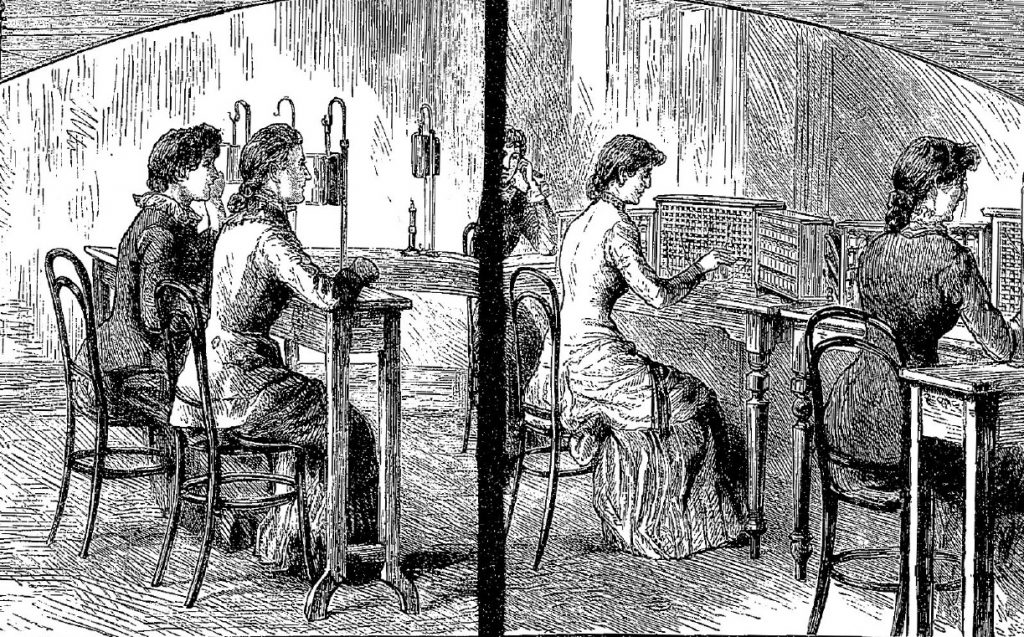
One aspect of exchange working which made a big difference to the experience of the subscriber was the type of switchboard used (Munro, 1888). All early switchboard models required two different types of operators: an answering operator would respond to subscribers’ calls to find out whom they wanted, and tell the connecting operator, who would make the connection (Occomore, 1995; Baldwin, 1925 pp 139-41). As this entailed a lot of speaking back and forth between operators, especially on the larger exchanges, there was considerable background noise, which one contemporary commentator noted ‘was by no means favourable to the rapid and accurate despatch of business’ (Electrician, 1888). Operators had to shout across the room to be heard, and one later recalled that those with the strongest lungs made the fastest connections (National Telephone Journal, 1907). The only way these operators knew if a conversation had finished was by listening in occasionally (Occomore, 1995), but many subscribers expressed resentment at this intrusion on their privacy (Hall, 1989; Milne, 2007).
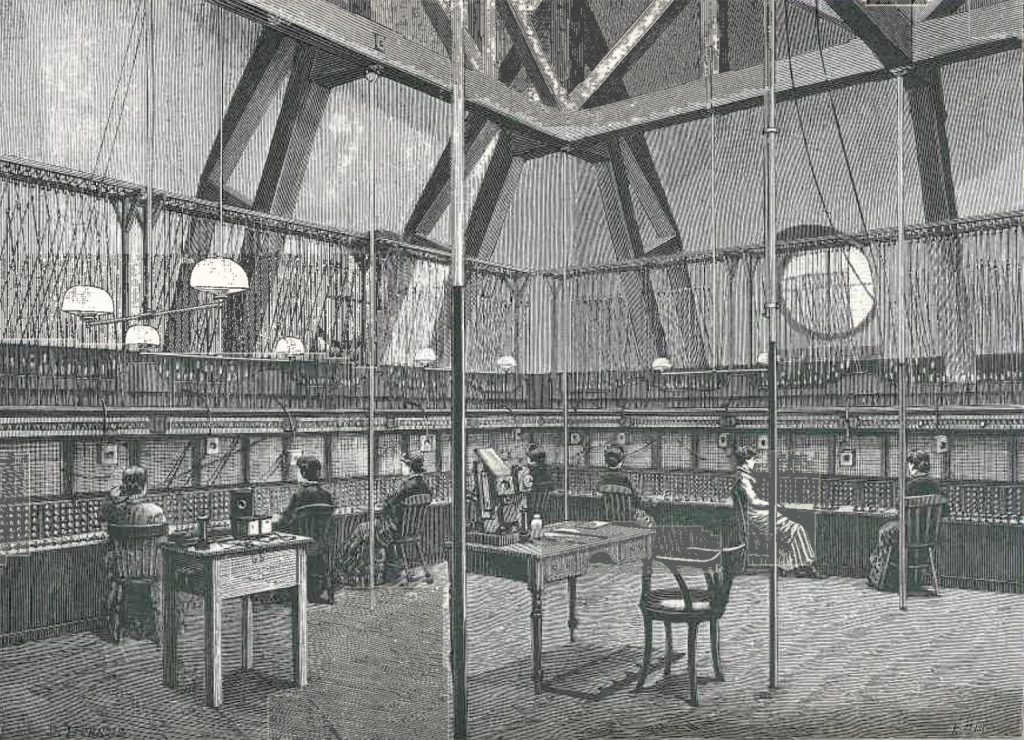
The alternative to these switchboards was multiple switchboards. On these boards each subscriber’s line was duplicated on every section of the switchboard, thus giving every operator access to every line coming in to the exchange. As each operator was responsible for a group of subscribers and was able to connect any one of them to any other subscriber without the assistance of another operator, connections were made more quickly (Occomore, 1995). Each section of the multiple switchboards accommodated two hundred subscribers, so they were good for larger exchanges such as Liverpool and Manchester where all the subscribers were concentrated into one exchange (Kingsbury, 1915 p 230; Munro, 1888). However, the amount of wire required to duplicate every subscriber’s wire across every operator’s position on the exchange made multiple boards an expensive investment in which companies did not rush to indulge (Electrician, 1888).
Use of multiple boards spread slowly; the UTC installed two multiple boards designed by one of their own electricians in late 1883 and early 1884, although patents held by the American company Western Electric prevented further development of this system (Occomore, 1995 p23-4). In 1884, the first Western Electric multiple switchboard was installed in Liverpool, although the first of this design to be used in London was not installed until 1888 (Munro, 1888; Occomore, 1995). In February 1888, when Bradford got a multiple switchboard, the only other places to be using them were London, Liverpool and Glasgow (Electrician, 1888).[21] In smaller telephone centres such as Edinburgh, for example, the exchanges were not large enough to justify the massive expense entailed by installing a multiple board, and so continued with older models (Electrician, 1888). Subscribers to exchanges using multiple boards would have found their operators easier to talk to, and their connection times quicker. This local heterogeneity of use-experience indicates that when considering complaints about telephony, it is important to take into account not just when an individual was complaining, but also where.
Complaints of delays in getting connected on the London system were common throughout this period (TJER, 1883; Electrician, 1891). They would later include those of the Duke of Marlborough, speaking in the House of Lords, writing to the Times, and in correspondence with Post Office officials (Marlborough, 1889; Marlborough, 1891).[22] This was probably due to the older types of switchboards still being used in many London exchanges (National Telephone Journal, 1908). In Bristol also, where the original, non-multiple switchboard remained in use until it was reaching capacity in 1893, subscribers had to exercise much patience when waiting at their instruments to be connected (Hall, 1989). A contrast can be drawn between these complaints and those raised in Liverpool by the council of the Liverpool Chamber of Commerce in late 1885. By this time Liverpool subscribers had been using the multiple board for over a year, and it is noteworthy that they did not complain about connection times. As all subscribers were on one exchange, served by an advanced model switchboard, it is likely that this was quite efficient.
The concerns they did express largely involved the operators themselves. Thus subscribers found that ‘…they were often cut off in conversation, without due notice; that they were frequently connected with wrong numbers; that there was a want of attention in the switch room, and there was a want of civility…’ (Electrician, 1886). The response of the chairman of the Lancashire and Cheshire Telephonic Exchange Company, Charles Moseley, to these complaints was essentially a series of frank admissions that the telephone was not a particularly useful or reliable instrument. He dismissed the complaints of subscribers being frequently cut off, and of distracting noises on the lines, as scientific issues beyond the company’s control. With regard to being connected to the wrong numbers, he said that all the subscribers knew that ‘in listening through a telephone it was very difficult sometimes to distinguish numbers, and even words had often to be spelt [sic]’ (Electrician, 1886). However, this complaint was obviously noted, as the next list of Liverpool subscribers to be produced after these complaints explicitly reminded users to ‘…be careful that the number you have given is repeated by the Operator, so as to prevent mistakes’ (L&C, 1886). The company’s response to these complaints was not to suggest any technical solutions such as metallic circuits, but rather to lower the expectations of the subscribers with regards to the capabilities of the technology itself, and to attempt to educate the users and modify their behaviour.
Moseley did concede that the complaint of incivility was very serious; however, lack of proper attention from operators was not just a problem in Liverpool. In early 1886 one London subscriber wrote to the Electrician to complain about the laxity and incompetence of the operators (Electrician, 1886). Implying that this had been going on for some time, he explained that subscribers were constantly told that the number they required was out of order. However, when the subscribers sent a telegram or a messenger, they found that there was nothing wrong with the other subscriber’s instrument. It is not clear what the response of the company was to this kind of complaint, but concerns regarding the conduct of the operators did not feature among the many worries expressed later by critics such as the Duke of Marlborough in the early 1890s. However, over the course of the 1880s the original male operators used on the exchanges, often boys who were found to be rude and rowdy, were replaced with women, whom managers thought to be more polite (Feuerstein, 1990). Although this happened at different rates around the country, and for example was still ongoing in London into the 1890s (National Telephone Journal, 1910 and 1911), such complaints as those detailed above were probably a key factor in this change. This, therefore, provides an important example in which complaints from users did effect real change in the system.
Difficult conversations
The problems of early exchange users did not end when they were eventually connected to their desired correspondent; for various reasons it was often difficult to hear well enough to carry on a conversation. William Preece, assistant engineer and electrician in the Post Office Telegraph Department, noted in 1877 that Bell’s original telephone (see Figure 5), which produced and detected undulating currents by means of magnets, was ‘limited in its range’ (Preece, 1877)[23] by interference on the line. The instrument, which could function as both a transmitter and a receiver, was not a powerful transmitter, and produced only weak signals. However, being very sensitive as a receiver, the receiving instruments would also produce interference noises from currents on nearby wires which nearly drowned out the faint sounds of the speaker’s voice (TJER, 1877). An editorial in the Times in May 1879 decried this ‘feebleness and uncertainty’ (Times, 1879) of the Bell telephone, and in a testimonial printed in the Telephone Company’s February 1880 list of subscribers, one private line user warned that ‘…the user of it should be somewhat acquainted with its mode of working and its tone before it can be fully appreciated…strangers hearing through it for the first time may find themselves on that account disappointed’ (UTC, 1880).
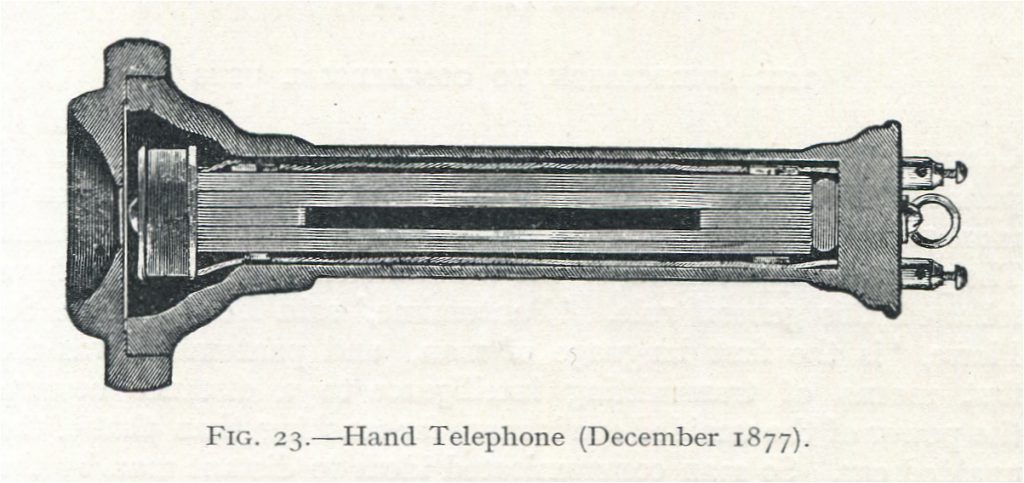
The Edison company’s transmitter, unlike Bell’s, employed the principle of variable resistance. At the heart of Edison’s design, and most transmitters subsequently, was carbon, the electrical resistance of which changes with pressure (see Figure 6). One advantage of this instrument was that weak vibrations at the transmitting end reduced the resistance of the carbon a little, and so sent weak currents to the receiver, and stronger vibrations reduced the resistance more, thus sending stronger currents (TJER, 1877). This reproduced the nuances of speech more accurately than Bell’s transmitter. The electrical current was produced by a battery, and not only from the action of the voice itself, as in Bell’s model, which ensured that the resulting transmission was much more powerful, and able to transmit stronger signals longer distances (Preece, 1877). The sound of the voice from the receiver would then be loud enough to overpower the interference from other electrical currents picked up by the sensitive Bell receiver. Indeed, from late 1879, when the Edison company began to operate, the Bell company was forced to improve its own transmitting apparatus. Instead of Bell instruments as transmitters, it began to supply a transmitter invented by the American Francis Blake, which worked on the same principle of variable resistance as the Edison transmitter (see Figures 7 and 8) (Electrician, 1887; Prescott, 1884).
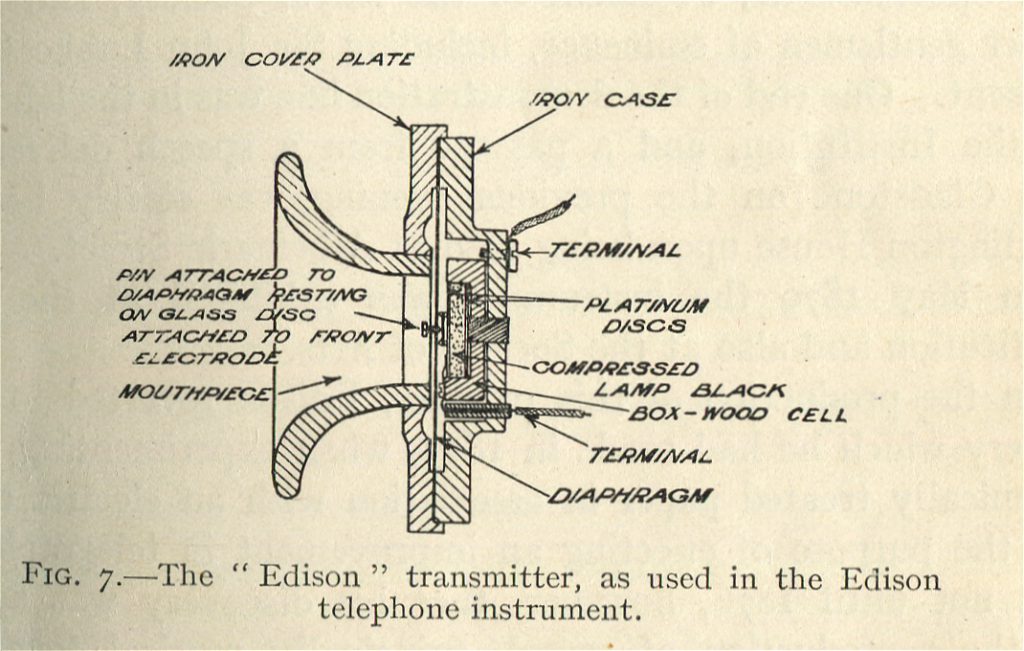

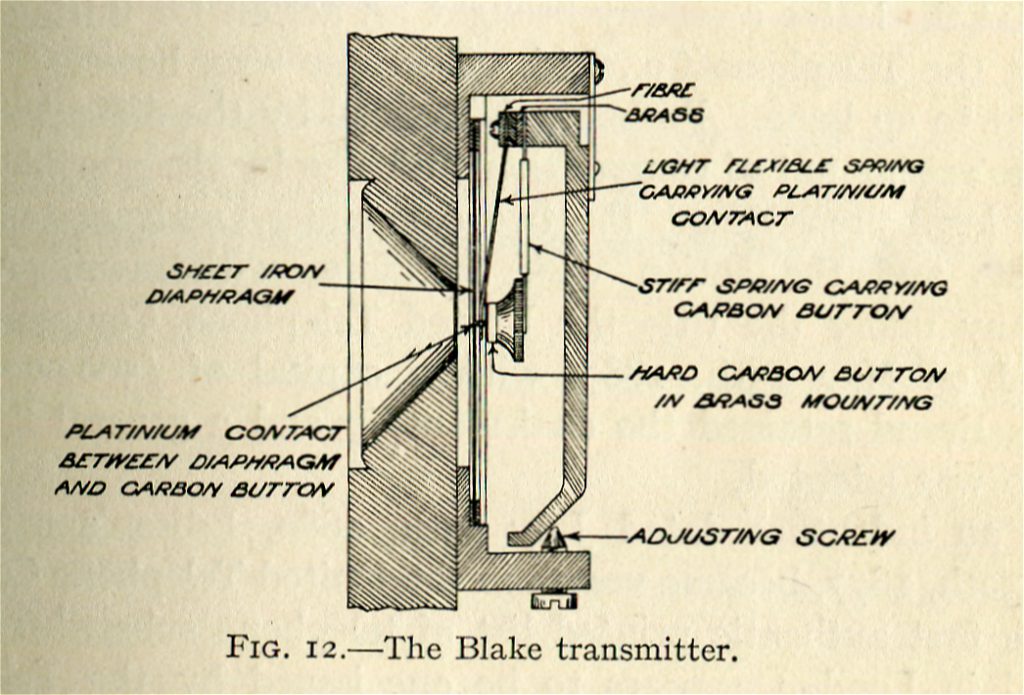
However, Edison’s receiving instrument was not so highly esteemed (see Figure 9). Called the electro-motograph, it employed the rotation of a moistened chalk cylinder in contact with an armature, itself attached to a diaphragm; the friction between the cylinder and the armature varied with the current, and this produced sounds from the diaphragm. It was incredibly sensitive, even picking up those softer or quieter sounds which Bell’s instrument was unable to reproduce, and it was loud enough to be heard throughout a large room (Du Moncel, 1879; Prescott, 1884). However, requiring a handle at the side of the instrument to be constantly turned during conversation, it was found to be too cumbrous, as Tilley reported, stating also that ‘…I could not understand one single word. The noise, for I can only call it a noise, strikingly resembled an exceedingly bad street Punch…’[24] It was not commercially successful (Electrician, 1887). John Kingsbury, an early writer on telephone history, cited George Bernard Shaw, who worked briefly for the Edison company, noting that the problem with the Edison receiver was that it was too loud, bellowing secrets which ought more properly to have been discretely whispered; this was certainly not what British stockbrokers wanted (Kingsbury, 1915). When the two telephone companies merged, the engineer of the Edison Company, Edward Johnson, recommended the use of the Bell receiver because of its greater simplicity, dismissing the other potential solution to the problems users were having with these telephones, that of educating them to use and appreciate them better (Kingsbury, 1915). Because the telephone was marketed from the beginning as an instrument requiring no skill to use, unlike the telegraph, it was important that this simplicity be maintained in practice (Kingsbury, 1915).
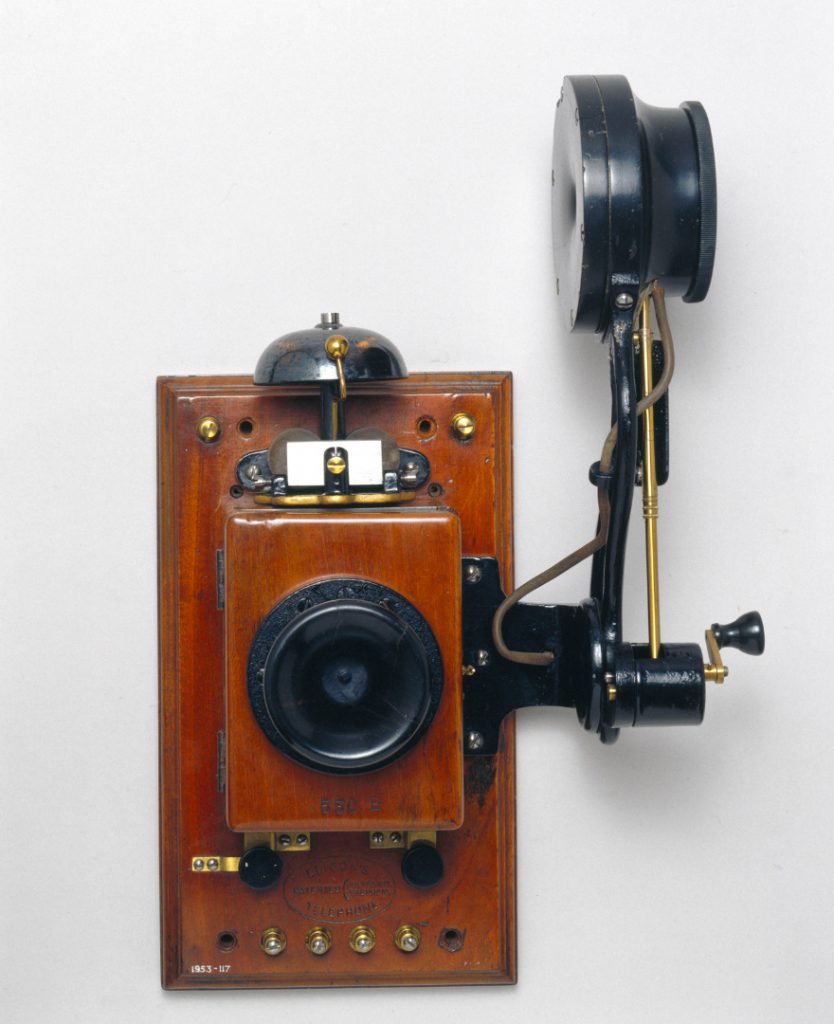
The first telephone the Post Office employed on a large scale, as it began to establish exchanges after the December 1880 court ruling, was the Gower-Bell telephone (see Figure 10) (Povey and Earl, 1988; Kieve, 1973). Kingsbury described the unit as a ‘microphone and a large Bell receiver fixed in the same case’ (Kingsbury, 1915). The transmitter was based on the Hughes microphone, which, invented in May 1878, used the variable resistance of carbon granules to produce an undulating current, but was not patented (Baldwin, 1925; Povey and Earl, 1988). The use of a big magnet made the Gower-Bell’s receiver more powerful, but too heavy to be comfortably held; instead it was mounted on the wall, and the user listened through two flexible hollow tubes (Povey and Earl, 1988). One key disadvantage when using this telephone was that the design of the instrument required the user to take and hold both tubes while speaking to activate the automatic switches which signalled the exchange, thus leaving no hands free for writing; most other wall-mounted telephones required only one hand for holding a receiver (Kingsbury, 1915). This problem would be the main cause of the complaint that the use of the telephone did not enable one to take any notes during a communication. This was a particularly pressing concern for those who required written records, such as the Army, which the Post Office supplied with these telephones (Nalder, 1958).
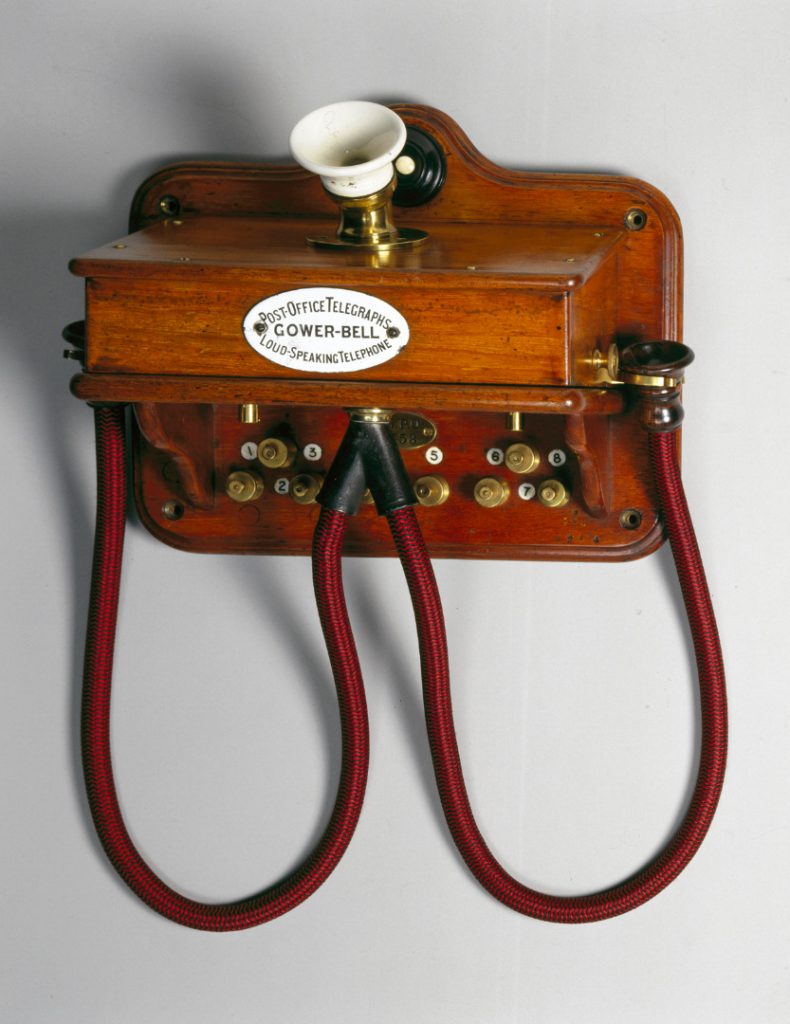
In addition to the instruments often being difficult to use, the exchange infrastructure, in the form of overhead wires, contributed to the frustrations of users. From the early days of telephony it was noted that single wires suspended on poles with no return circuit, but using the earth itself instead, suffered from electrical interference which caused difficulties in hearing (TJER, 1877).[25] Thus a user picking up a telephone instrument would often hear a background noise which Preece likened to the sound of hail pattering against a window (Preece, 1877). In 1890, in London, the Duke of Marlborough despaired that ‘I have to write more letters of apology for conversations that fail to be heard than I ever can get convers[ations] with others’.[26] Indeed, such complaints were expressed across the country,[27] and at certain times of day the background noise on single wire systems sometimes made conversation difficult, or even impossible (Electrician, 1890). As Preece noted, the problem of inductive interference from nearby telegraph wires was even more serious in British telephony than elsewhere because Britain employed Wheatstone high speed telegraphy, the ‘tremendous roar’ from which would drown out the small telephone currents (Kingsbury, 1915).[28] Thus, in some cases, British telephony was a victim of the technical success of British telegraphy.
As well as irritating background noises, there was for many businessmen a more serious concern: where single telephone wires ran parallel to one another for an appreciable distance, conversations held on one could often be overheard on the others (Electrician, 1890). London subscribers, and potential subscribers, were still being put off by this cross-talk by 1891 (Electrician, 1891). Subscribers to the Manchester Mutual Company in 1892 were glad to feel that they had privacy during their conversations on the company’s new metallic circuit system, which used a second wire to return the current; this created a closed circuit which was not affected by induction. In addition, they mentioned that the company’s trunk line, to Bolton, was also very clear, one noting that they were ‘surprised at the clearness of voice and were much struck with the entire freedom from the confusing sounds which are so prominent on the other trunks’.[29] The other trunks available in the Manchester region, by this point run by the NTC, were all single wire, and were known for suffering from a lot of cross-talk (Munro, 1888).
As well as the Mutual Company, the Post Office’s exchanges around the country all used metallic circuits. Even Colonel Jackson, chairman of the NTC, had to admit in February 1892 that in Newcastle, where there were successful Post Office and company exchanges, subscribers often paid to use both: they used the company exchange because of its trunk line connections to other towns and cities, but they used the Post Office system because the lines were better (Electrician, 1892). However, metallic circuits were more expensive than single wires because they used twice as much wire, and subscription to Post Office exchanges was more expensive as a result (Electrician, 1891).
In this section, as with the previous, from a business or engineering history perspective it might appear that the sole driver of the technological changes discussed was the need of the companies to optimise the physical components of the system in order to improve the clarity of the instruments or the efficiency of the exchange. However, this does not take into account the importance of the human components of telephone systems, who exercised a degree of control over the development of the system through deciding whether or not to join it, as noted in the introduction. In particular the complaints generated by these problems were an important factor in the spread of telephony because they were made in public forums such as Chambers of Commerce, where many potential users could be influenced, and in newspapers. These complaints therefore affected the decisions of other users and non-users to adopt and maintain, or to reject, the telephone for themselves, and this provided a further incentive for the telephone companies to act on them.
The ‘mighty cobweb’
As well as making conversations difficult for telephone users, the system of overhead wires was also the source of other complaints – from non-users as well as users – namely that the wires were ugly, and, worse, dangerous (Baldwin, 1925). In the House of Lords, the Duke of Marlborough said of London in 1889 that he thought there was not a single town in Europe which had been ‘so disfigured, by wires running in all directions’ (Marlborough, 1889). Where the aesthetic qualities of a town were of particular note, overhead wires could be opposed as being bad for tourism. In Bath, one local council alderman referred to the networks of telephone wires seen in other towns as ‘a mighty cobweb’ (Hall, 1989). When the Bath Town Council discussed the establishment of an exchange, one member pointed out that Bath was not a commercial town but rather a resort for visitors, and so he was loath to see the city disfigured by overhead wires, and another asked whether it was worth stringing wires over the streets for the benefit of only ten or twenty people (Electrician, 1885). These complaints came from non-users who, it appears, were in no hurry to use the telephone themselves; if so few people were to benefit from telephone use, then they preferred to prioritise a different concern: keeping their town free of ugly wires.
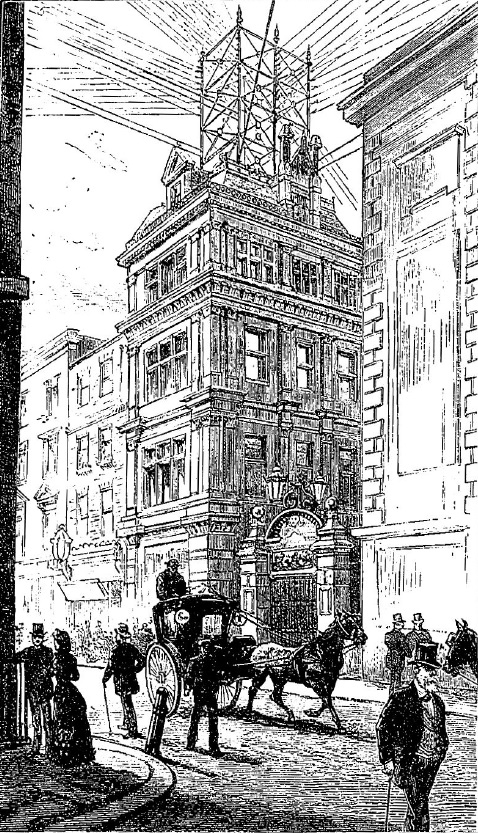
Whilst debating the relative merits of two different methods of running telephone wires – the ‘cross’ system and the ‘twist’ system – in 1891, telephone engineer Alfred Rosling Bennett argued that one, the twist system, resulted in a much uglier configuration of wires (Bennett, 1891). Bennett noted: ‘[t]elephone trunk lines have frequently to be carried past gentlemen’s houses, and across estates. In such cases, as in dealing with road trustees and county councilmen, sightliness is of material moment, as any telephone manager who has to procure wayleaves knows.’ (1891) Thus, because the procurement of wayleaves – the permission to place wires on people’s property – required the consent of landowners, Bennett recommended the ‘cross’ system. In this way the opinions and complaints of these non-users influenced the technical decisions of the engineers in charge of the exchange systems.
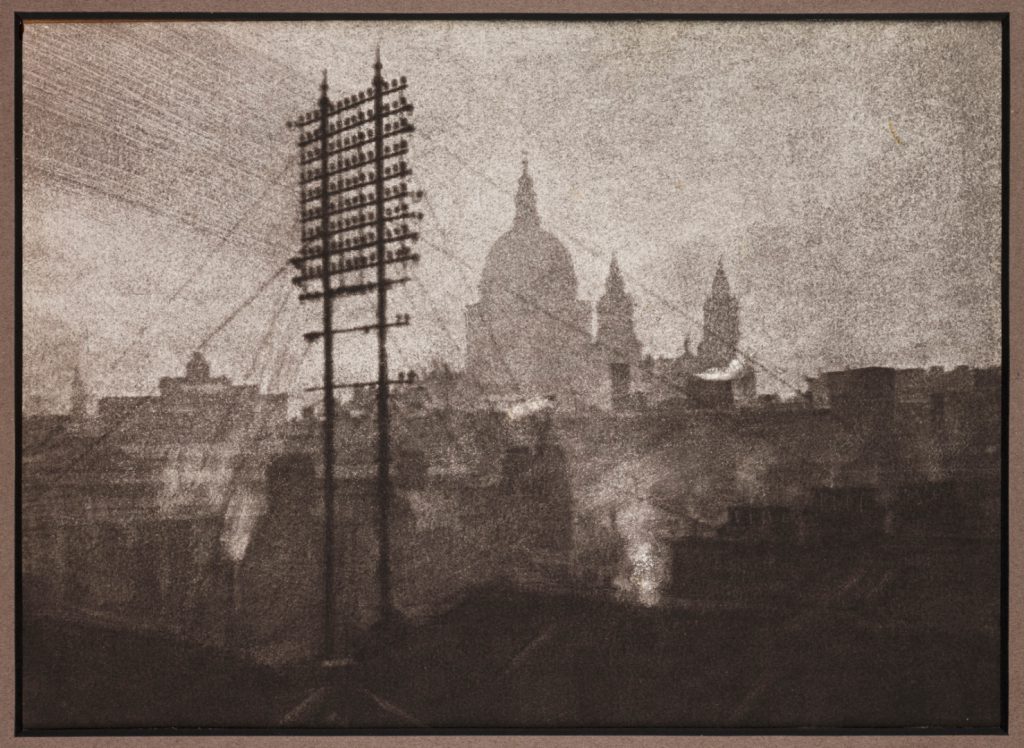
More serious, however, was the concern that the wires would fall and damage property or hurt someone. One correspondent to the Standard as early as 1882 noted that the number of falling wire accidents would increase as the wires became corroded and worn. In addition, a fire at a large exchange might damage the wires which led into the building such that they could all fall on the surrounding area, damaging property and probably killing people (Standard, 1882). This sentiment was still being expressed years later, in 1893 (Manchester Guardian, 1893). Some well publicised accidents served to reinforce this worry. In 1883 an overhead wire fell in London and, as it ‘twisted and turned in a serpent-like fashion in the air’ (Standard, 1883),[30] cut an elderly lady across the face and head; in 1884 a five-year-old girl was severely injured by a falling wire (TJER, 1884). Less than a month later a man wrote to the Times describing how he had prevented a telephone company employee from erecting a wire over a communal garden which he shared because of the potential danger to residents and their children, encouraging others to do likewise (Bonham-Carter, 1883).
The most common solution suggested for these problems was to place the wires underground.[31] The public commotion surrounding these issues led to the formation in 1885 of a government Select Committee on Telephone and Telegraph Wires to investigate the dangers posed by overhead wires, including telegraph and electric lighting wires. However, in May the committee concluded that the risk to the public was greatly exaggerated (UK Parliament, 1885). Thus, this problem was addressed by an official investigation, but was dismissed, and so no technical actions were taken to placate those complaining about this aspect of telephony, who were predominantly non-users. Additionally, placing wires underground also required granting the companies permission to break up the streets. Although, as a government department, the Post Office had the right to do this without seeking specific wayleaves from local councils, the private companies did not have this power, and in general the public – including local authorities, property owners, and amenities companies – were unwilling to grant such permissions because of the disruption it would cause as the streets were dug up (Baldwin, 1925). Thus, into the 1890s the only solution for those who objected to the appearance or dangers of the wires was even more disagreeable than the wires themselves.
However, even after the Select Committee reported that the wires were safe, many non-users still thought they were ugly, if not dangerous, and continued to deny wayleaves to the companies. The effect of this is hard to quantify. Nevertheless, the fact that Bennett, in 1891, recommended configuring overhead wires in a way that would be least unsightly for landowners indicates that this was certainly a concern for telephone suppliers (Bennett, 1891). Indeed, complaints about the danger and appearance of overhead wires, largely by non-users, continued into the 1900s (Stein, 1996). Thus it is apparent that the non-users on whom the companies depended for wayleaves had considerable influence over the development of the early exchange system.
Controlling access
The concern that the telephone would make life more stressful for its users by its intrusive nature was expressed even before the first exchange was established in Britain. An editorial in the Times in May 1879 warned that modern life had already been made too fast and complicated by the invention of the telegraph. Prior to its employment in commerce, a businessman could plan his day after receiving the morning post, but now telegrams, brought by messengers, could arrive at any time, bringing answers to questions, new requests, or information which had to be acted on urgently (Times, 1879). This, the Times lamented, would be worse with the telephone, as making telephone calls was easier than sending telegrams, and so people would have fewer reservations about calling regarding smaller, more trivial matters. As the Times was read by a large proportion of wealthy commercial, industrial and professional men, this concern for the increasing pace of life was probably representative.
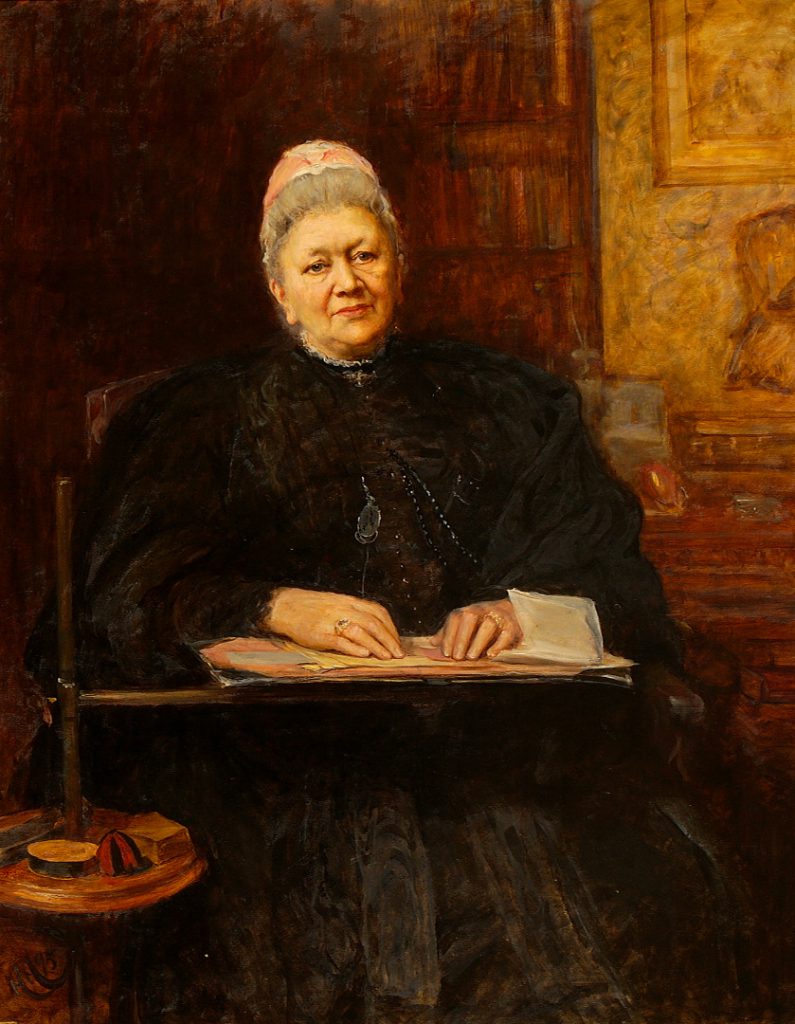
In October 1882, Phebe Lankester, a writer on botany and health (Shteir, 2004), detailed her encounter with an exchange telephone at a friend’s house for her syndicated women’s column for provincial newspapers; she concurred with this assessment of the telephone as a technology which would interrupt the course of daily life (Lankester, 1882). Lankester disliked the prospect of being summoned to the telephone by a bell, which, perhaps, might have been too similar to the manner in which servants were summoned. It is unlikely that Lankester’s readership included many people who could have afforded a telephone in this period, and so the fears she expressed were probably not immediately relevant to them. Nevertheless, both the editorial in the Times and Lankester’s speculations imply a concern among non-users that in the indefinite future people may feel impelled to have a telephone in order to continue to be financially successful, or to keep up with friends. This kind of unwilling use of exchange telephones is evidence of the inertia of exchange growth, whereby users joined the system reluctantly, a phenomenon which, one could argue, can also be seen at work today in the growth of social media platforms.
The Times noted that as there were limits to human tolerance there would surely be a way of keeping this new evil of constant telephonic interruptions within reasonable bounds. The telephone companies themselves, possibly in response to such sentiment, suggested just such a solution. In their February 1882 list of subscribers the UTC proposed that people in this position should have an instrument in their office and another, equipped with switching apparatus, outside, under the care of a clerk (see Figure 14) (UTC, 1882). When the telephone rang, the clerk would answer, ascertain whether the person really needed to speak with the subscriber, and only then, if necessary, would he switch the caller through to the office. Likewise the busy subscriber could ask his clerk to ring up a desired number and only switch the call through to the office telephone when the connection had been made, thus saving valuable time waiting at the instrument.
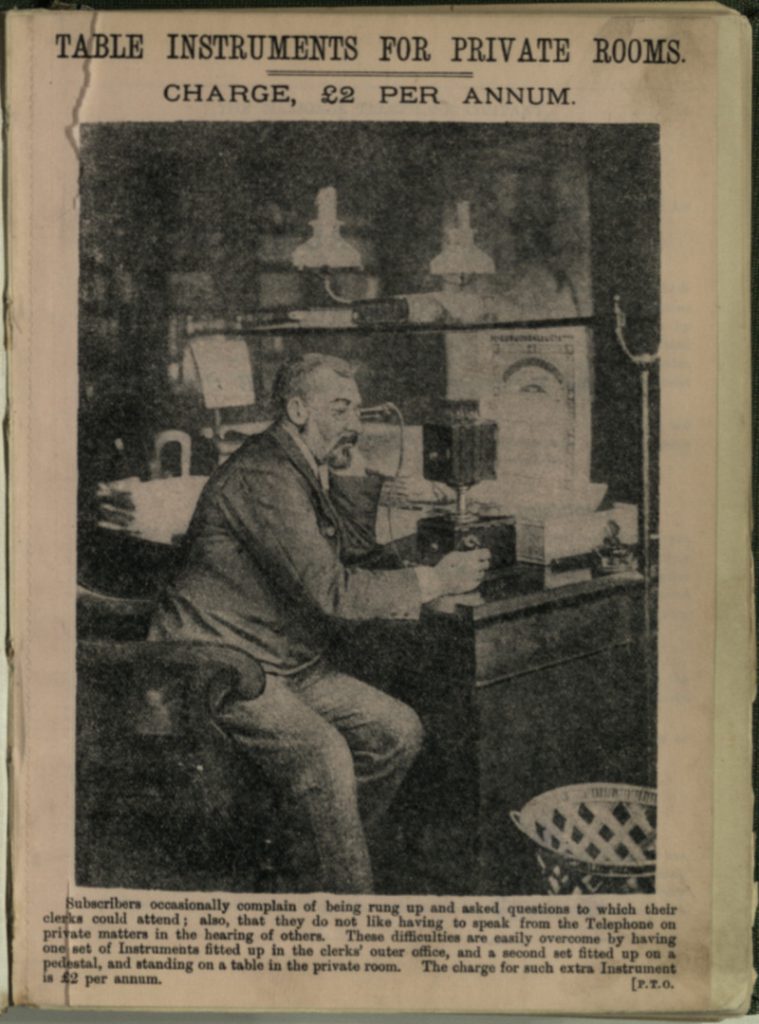
This was a solution aimed at the problem of screening important from less important calls. However, there was also another problem: that of the wrong people, or wrong kinds of people, having access to subscribers in a conversational capacity. One Edinburgh subscriber raised just such a complaint in 1884 when the first public call boxes were being installed: ‘…any person off the street may for a trifling payment – a penny is suggested in some cases – ring up any subscriber, and insist on holding a conversation with him.’ (TJER, 1884) He considered this possibility most objectionable, and sufficient reason if it went ahead for him to cancel his subscription. He said that the telephone was intrusive, and forced subscribers to stop whatever they were doing when it rang to speak to the person at the other end, even if the caller, appearing in person, would have ‘no claim to such prompt or exclusive attention’ (TJER, 1884). If all subscribers were in the same position, he continued, this was tolerable, as they would not desire to waste one another’s time. However, he argued that if anyone could insist on being listened to by the leading businessmen of the city they would be forced to protect themselves by paying less attention to telephone calls in general.
This user was effectively in favour of limiting the number of people who could use the telephone rather than putting in place mechanisms to screen his calls. He was made uncomfortable by the thought of being accessible to people with whom he would not normally desire to interact, and would consider giving up the conveniences of the telephone himself if this danger became real. Such complaints as these required a change in attitude on the part of users who wished to keep their telephones: the only technical solution offered by the companies was that of installing an extra instrument so that a subscriber’s clerk could screen his calls, noted above. None of the UTC group companies’ directories in this period offered subscribers the option to have their numbers left out of the published lists of subscribers in order to increase their privacy. Lists of subscribers acted as advertisements for the companies’ services as much as directories for their subscribers, and it was therefore not in the companies’ interest to allow subscribers to opt out of inclusion in their directories.
Conclusions
https://dx.doi.org/10.15180/150308/005This article has examined the early years of a now ubiquitous technology, asking how it came to be so without assuming that this was in any way inevitable, as has often been tacitly assumed in existing histories. The complaints explored above demonstrate the broad range of difficulties of using early telephone exchange systems, from technical problems to social concerns. In demonstrating these difficulties, it should be clear that it was not necessarily seen as beneficial or desirable to adopt exchange telephony during this period. These problems should also be seen within a context of other communications alternatives. For example, the quality of the postal service, the availability of messengers, and the efficiency of the British telegraph system all provided tough competition, and raised the standard expected of telephony (Kingsbury, 1915; Perry, 1977). This was a standard which, in its early years, telephony did not meet. Not only could using early telephones be a very frustrating experience, but the problems of telephony were not experienced solely by the users. Regarding the granting of wayleaves for overhead wires, non-users had a strong influence over the expansion of the network. However, concerns expressed by users, who were already paying for their service, were often not heeded by the company unless there was a threat of competition, and the preferred solution to users’ complaints was often to attempt to lower expectations of the technology itself and educate subscribers accordingly.
Nevertheless, it is clear that user complaints regarding operators were a key factor in the replacing of male with female operators in the 1880s. User preferences also determined the instruments used – for example, the Edison receiver was abandoned as not being fit for purpose. Focusing on problems has also highlighted the heterogeneity of telephone systems across different times and places, and has consequently revealed the variety of user experiences. With this in mind the diverse range of responses to telephony can be better understood, in Britain and elsewhere around the world. Users and non-users were always responding to localised experiences of telephony, in specific locations at specific times. These problems exerted varying degrees of pressure on the development of telephone systems during this period, which indicates the importance of including the social components, the users, within any analysis of a system, as Gooday asserts. Nevertheless, without the incentive of competition the complaints of users about telephone instruments or systems did not make much difference.
In support of Wyatt’s thesis that non-users of technologies are also important in shaping those technologies, it is possible to argue that, while the companies had no legal rights to place their infrastructure where they wished, the greatest influence over the embryonic exchange system was exerted by those non-users to whom the companies had to turn for wayleaves. These landowners could charge a great deal for permission to place poles and wires on their property, or demand the removal of plant for which they had previously granted permission. Many people did not want dangerous, ugly wires defacing their cities and countryside, and this aversion continued to make telephone development difficult and expensive for many years.[32]
Finally, therefore, considering how difficult telephone use could be, it is pertinent to question not why exchange telephony did not grow rapidly in this period, as Perry asked (Perry 1977), but why people invested their time and money in the system in the first place. It appears there were very few groups of users who had no complaints at all; even the relatively well-served Manchester and Liverpool communities, with big, wealthy commercial users and arguably some of the best equipment in the country, were not happy with their service. I suggest that the answer lay in their expectation of the potential of the system from hearing reports of the situation in the US. As Perry has pointed out, comparisons were often made and the numbers of telephone users active in the USA was pointed out in the press (Times, 1882; TJER, 1883; Electrician, 1885). The expectation that telephony could be better somewhere else was important; Jon Agar has provided another example of this phenomenon in the case of mobile telephony a century later. Subscribers to Paris’s new mobile cellular telephone network were complaining about the service they were receiving, and Agar noted ‘the telling observation of France Telecom’s Philippe Dupuis in 1988: “If it had not been demonstrated in other countries that mobile communications can become more abundant and cheaper, everyone would be happy.”'(Agar, 2013) Thus, it may have been this expectation, and not the inherent merits of the technology itself at the time, which drove people to subscribe and to remain subscribed to early British exchange systems.
Footnotes
Back to text
Back to text
Back to text
Back to text
Back to text
Back to text
Back to text
Back to text
Back to text
Back to text
Back to text
Back to text
Back to text
Back to text
Back to text
Back to text
Back to text
Back to text
Back to text
Back to text
Back to text
Back to text
Back to text
Back to text
Back to text
Back to text
Back to text
Back to text
Back to text
Back to text
Back to text
Back to text

